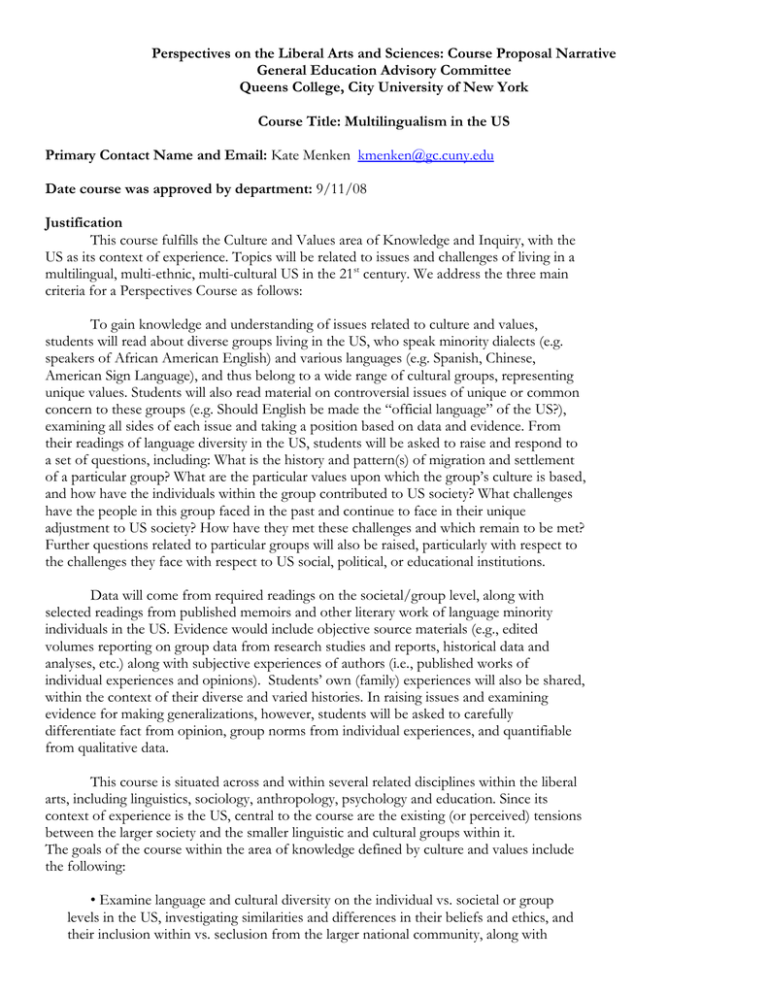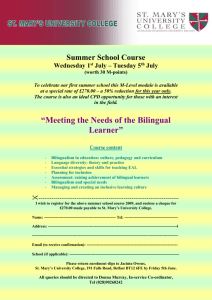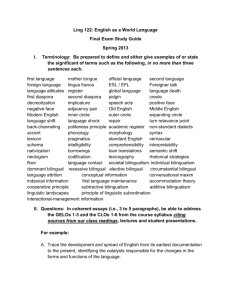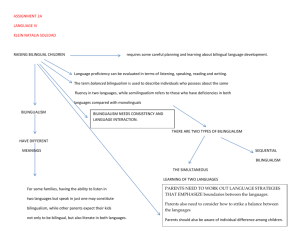Perspectives on the Liberal Arts and Sciences: Course Proposal Narrative
advertisement

Perspectives on the Liberal Arts and Sciences: Course Proposal Narrative General Education Advisory Committee Queens College, City University of New York Course Title: Multilingualism in the US Primary Contact Name and Email: Kate Menken kmenken@gc.cuny.edu Date course was approved by department: 9/11/08 Justification This course fulfills the Culture and Values area of Knowledge and Inquiry, with the US as its context of experience. Topics will be related to issues and challenges of living in a multilingual, multi-ethnic, multi-cultural US in the 21st century. We address the three main criteria for a Perspectives Course as follows: To gain knowledge and understanding of issues related to culture and values, students will read about diverse groups living in the US, who speak minority dialects (e.g. speakers of African American English) and various languages (e.g. Spanish, Chinese, American Sign Language), and thus belong to a wide range of cultural groups, representing unique values. Students will also read material on controversial issues of unique or common concern to these groups (e.g. Should English be made the “official language” of the US?), examining all sides of each issue and taking a position based on data and evidence. From their readings of language diversity in the US, students will be asked to raise and respond to a set of questions, including: What is the history and pattern(s) of migration and settlement of a particular group? What are the particular values upon which the group’s culture is based, and how have the individuals within the group contributed to US society? What challenges have the people in this group faced in the past and continue to face in their unique adjustment to US society? How have they met these challenges and which remain to be met? Further questions related to particular groups will also be raised, particularly with respect to the challenges they face with respect to US social, political, or educational institutions. Data will come from required readings on the societal/group level, along with selected readings from published memoirs and other literary work of language minority individuals in the US. Evidence would include objective source materials (e.g., edited volumes reporting on group data from research studies and reports, historical data and analyses, etc.) along with subjective experiences of authors (i.e., published works of individual experiences and opinions). Students’ own (family) experiences will also be shared, within the context of their diverse and varied histories. In raising issues and examining evidence for making generalizations, however, students will be asked to carefully differentiate fact from opinion, group norms from individual experiences, and quantifiable from qualitative data. This course is situated across and within several related disciplines within the liberal arts, including linguistics, sociology, anthropology, psychology and education. Since its context of experience is the US, central to the course are the existing (or perceived) tensions between the larger society and the smaller linguistic and cultural groups within it. The goals of the course within the area of knowledge defined by culture and values include the following: • Examine language and cultural diversity on the individual vs. societal or group levels in the US, investigating similarities and differences in their beliefs and ethics, and their inclusion within vs. seclusion from the larger national community, along with understanding how different groups contribute to the democratic values and institutions that constitute the “American way of life.” • Raise political, social, educational and moral questions and issues that relate to language diversity in the US, take positions on controversial issues related to the challenges of incorporating diverse linguistic and cultural groups into US society, and defend each position based on readings and discussion. This course also addresses some of the additional criteria for Perspective Courses: 1. It is comparative in approach in that it will describe and compare different groups within US society. 2. The nature of the course has diversity as its theme, with description and analysis of the particular form (i.e. cultural and/or linguistic) that this diversity takes. 3. Students’ active inquiry into the linguistic and cultural issues brought up in this course will take the form of analysis and synthesis of a wide variety of written (and perhaps oral) data, leading to the statement and support of an opinion on a related, controversial issue. 4. In examining the migration and settlement history of various groups that make up US society, students will learn how this history has changed over time and how patterns of migration and settlement affect the development of US institutions depending on the zeitgeist of the times. 5. The use of primary documents and materials will be an integral part of the readings and data of this course. Course Materials, Assignments, and Activities Readings: (Please note that the core texts are Finnegan and Rickford (2004) and Santa Ana (2004), which are highlighted below with an asterix (*). In addition, there are selected supplemental readings from books and journals, as indicated below). Baker, C. (2006). Foundations of Bilingual Education and Bilingualism. 4th Edition. Clevedon, England: Multilingual Matters. This introductory course text offers an in-depth survey of bilingualism and bilingual education.Crawford, J. (2000). At war with diversity: US language policy in an age of anxiety. Clevedon, Avon: Multilingual Matters. This collection of essays explores the history of the English-only and anti-bilingual education movements in the US, and examinnglish-only movement. It also explores the politicization of the es the difficulty that Americans have in accepting bilingualism. The book also details efforts to resist English-only, such as in Native American revitalization programs. Crawford, J. (2000). At war with diversity: US language policy in an age of anxiety, Chapter 1. Clevedon, Avon: Multilingual Matters. This book offers in accessible language a detailed overview of how bilingualism has historically been addressed in the US, and the evolution of the Eschooling of bilingual immigrant students. Cummins, J. (2000). Language, power, and pedagogy: Bilingual children in the crossfire. Clevedon, Avon: Multilingual Matters. This introductory course textbook examines bilingual education and the sociopolitical context which surrounds the education of bilingual children. *Finnegan, E. and Rickford, J. (eds). 2004. Language in the USA: Themes for the 21st Century 2004. Cambridge University Press. Contains essays from a wide variety of noted scholars in the field of linguistic and cultural diversity, who describe and analyze this diversity on a societal level, with (mostly) objective evidence from research and reports. Divided into three sections, each of which supports one or more goals of the course: 1. American English (e.g. African American English) 2. Other language varieties (e.g. Multilingualism and non-English mother tongues); 3. The Sociolinguistic Situation (e.g. Language ideology and language prejudice) García, O. and Fishman, J. (Eds). (2002). The Multilingual Apple: Languages in New York City. Mouton de Gruyer. This edited volume examines different languages in New York City, 2 such as Spanish, Chinese, Yiddish, and Haitian Creole in terms of their current usage and the likelihood of their maintenance over time. Hakuta, K. 1984. Chap 7. Mirror of Language. The debate on bilingualism. Basic Books. This chapter provides an overview of different linguistic minorities in the US, a useful introduction to the course. Hoffman, C. 1991. Chaps 1 and 8. An Introduction to Bilingualism. Longman. These chapters outline the differences between individual bilingualism (Chap 1) and societal bilingualism (Chap 8), an important distinction that provides the basis for class readings and discussion. Myers-Scotton, C. (2005). Multiple Voices: An Introduction to Bilingualism. Wiley-Blackwell. This introductory textbook on bilingualism is extremely accessible, appropriate for undergraduate students in diverse majors. Topics covered include language maintenance, language ideology, inter-cultural communication, lexical and grammatical borrowing, and language globalization Ricento, T. (Ed.). (2006). An introduction to language policy: Theory and method. Malden, MA: Blackwell Publishing. This textbook offers an introduction to language policy, which pertains to such issues as the status of different languages within society, the education of those languages, efforts to promote the spread or revitalization of languages, and language ideology. Romaine, S. (1995). Bilingualism. Wiley-Blackwell. This introduction to the sociolinguistics of bilingualism explores various aspects of bilingualism, such as code switching, language mixing, and language and cognitive development. *Santa Ana, O. (2004). (Ed.). Tongue-tied: The lives of multilingual children in public education. New York: Rowman & Littlefield. An anthology of first-person accounts by language minority speakers in the US, including famous writers such as Amy Tan, bell hooks, Richard Rodriguez, and Maxine Hong Kingston as well as academic writers such as Guadalupe Valdés, Gloria Anzaldúa, and Lisa Delpit. Zentella, A-C. 1997. Growing Up Bilingual. Blackwell. A research study of 20 families in the Spanish-speaking Puerto Rican community in New York, providing insights on a group level as well as individual case studies reporting on the issues and challenges faced by this particular, disadvantaged community. Zentella, A. (2005). (Ed.) Building on Strengths: Language And Literacy in Latino Families And Communities. Teachers College Press. This edited volume explores language socialization in Latino families. The book offers a historical, political, and cultural context for the language attitudes and socialization practices that help determine what and how Latino children speak, read, and write. Major Assignments and student activities: Presentation of Readings. In this course, students will be divided into small groups for the duration of the semester. Each group will be responsible for leading a class discussion about course readings once during the semester. In these presentations, students are not to summarize the readings, but instead engage peers in conversation and/or debate about key issues the readings raise. Small groups will also meet occasionally during course meetings for class discussions. Linguistic Histories: Students will research their family’s linguistic history, using oral interviews with family members, documents and other written sources, to determine patterns of family language or dialect maintenance, change and/or loss, as well as the family’s history of and attitudes towards acquiring American English. Final Research Project: Case Study. Students are required to select a case study for their final paper on a language or language variety that is of interest to the student. In this paper, 3 students are to overview research that has been written about their selected language or language variety, weaving in documented experiences of the speakers of that language/language variety. In their discussion of research findings, students are encouraged to incorporate their personal experiences, particularly if they are speakers of the language or variety they have selected. Assessment Forms of evidence (to be archived) that course is meeting its goals: 1. 2. 3. 4. Collection of syllabi, to include course goals Samples of activities and assessments used to meet each goal, with materials (e.g. handouts, exams) included Sample of student work used to meet each goal, along with rubric for how the work was evaluated Student grades in assessments given Evidence of effective teaching and learning would include teacher observations, as required, and student evaluations, in addition to 1-4 as given above. Administration After course has been given a few times, teachers and students will be asked to evaluate it and recommend changes to topics, readings, activities or assessments. An evaluation form will be developed to ease and systematize this process. The course would be taught by a combination of full-time and adjunct faculty members, who would meet regularly with the departmental TESOL committee. 4






